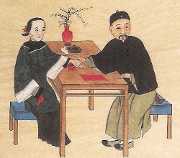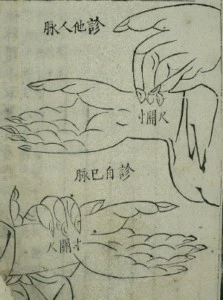Pulse Diagnosis in Chinese Medicine - Starting A Modern Scientific Method

Chinese Medicine is as much an art as it is a science. One of the strongest values of Chinese Medicine is how a practitioner can look deeply into each patient and find the causal factors driving their illnesses and tailor a treatment directly to them. There is an intuitive part to this, an artistic part and a scientific part - all of which are fostered by training and clinical experiences.
To uncover and ultimately treat these underlying diagnostic "patterns" the Chinese Medicine practitioner utilizes many diagnostic tools. The most common ones are described within the "examinations and diagnosis" section on our theory site.
Of these tongue diagnosis and pulse diagnosis are arguably the most important and most clinically valid. Tongue diagnosis has the benefit, in my opinion, of being far less subjective - in other words more practitioners will see the same things on the tongue in the same way when compared with how they might come to different conclusions with the pulse. The pulse, however, will show a wider range of imbalances and can be extremely useful in deciphering the root of mixed patterns.
 In pulse diagnosis you are looking for certain qualities of the pulse (not just rate as most would assume). So terms such as "slippery", "wiry", etc. are used in conjunction with certain pulse positions. There are a few alternate pulse positions to check on the wrist and then others elsewhere on the body. A common positional understanding includes 3 positions on each wrist along the radial artery starting behind the wrist crease. On the left wrist closest to the crease you see relationships with the heart system, the liver behind that and the kidney behind that and on the right wrist you have the lung system at the crease, the spleen system behind that and the mingmen behind that.
In pulse diagnosis you are looking for certain qualities of the pulse (not just rate as most would assume). So terms such as "slippery", "wiry", etc. are used in conjunction with certain pulse positions. There are a few alternate pulse positions to check on the wrist and then others elsewhere on the body. A common positional understanding includes 3 positions on each wrist along the radial artery starting behind the wrist crease. On the left wrist closest to the crease you see relationships with the heart system, the liver behind that and the kidney behind that and on the right wrist you have the lung system at the crease, the spleen system behind that and the mingmen behind that.
Left Wrist Right Wrist
Cun (inch) - 1st position HT / SI LU / LI
Guan (barr) - 2nd position LV / GB SP / ST
Chi (foot) - 3rd position KD / UB Mingmen / Lower Burner
A basic diagnostic example might be as follows: For someone that we might reference as "stressed out" in the west - they might have what we call "liver qi stagnation" in Chinese Medicine. We wouldn't, however, just assume they have this diagnosis because they describe being "stressed out" (see "treating the cause and not the symptoms" for more on this) - we would come to this conclusion from using all of the diagnostic tools referenced above. Their tongue might be purple which can indicate "stagnation"
particularly on the sides which is the "liver" area on the tongue, and their pulse might be "wiry" - particularly in the 2nd left wrist position which correlates with the liver system. That, of course, is a very simplified example.
Now one of the problems with pulse diagnosis as I hinted at above is that it can be quite subjective once you get beyond the more simple cases. You could line up 50 tcm doctors and have them all look at the tongue and pulse and with the tongue you would (just guessing here) get probably 40 out of 50 in agreement with only mild nuances differing, but with the pulse you might get 10 out of 50 - partially because it is offering more information admittedly and there are different systems of correlations. But, in my experience and opinion, it would be different (an interesting study to perform for those researchers that might be reading this).
To compensate for this arguable lack of precision a group of researchers from Taiwan recently conducted a study looking at more scientifically measurable pulse variations and trying to group them into diagnostic categories. Involving researchers from the division of cardiology at the Chang Gung Memorial Hospital and the Institute of Traditional Medicine at National Yang-Ming University among others they aimed to correlate a range of pulse wave parameters and heart rate variability with standard TCM diagnoses.
To perform the study they recruited 69 relatively healthy volunteers and utilized a wrist blood pressure cuff called "ANSWatch" and obtained pulse readings at the left guan position (the liver area). Utilizing a range of measurements including blood pressure, augmentation index and subendocardial viability index they tried correlating these to each volunteers diagnosis in Chinese Medicine terms.
The researchers found:
- Those with qi deficiency had higher augmentation index scores and lower diastolic blood pressure.
- This with yang deficiency had lower systolic blood pressure, lower pulse pressure and lower dP/dt max (a measure of ventricular contraction strength).
- This with damp-heat had higher subendocardial viability index scores.
Now there are a million caveats with a study of this nature all indicating that there is much more research to be done before this would lead to clinically valid ways of obtaining or helping to confirm diagnoses in Chinese Medicine. But this is a nice approach to using modern western diagnostic tools with time proven traditional medicine tools. Particularly since proper diagnosis is so crucial within Chinese Medicine to obtain the best clinical outcomes.
tag @yinyanghouse for questions/comments